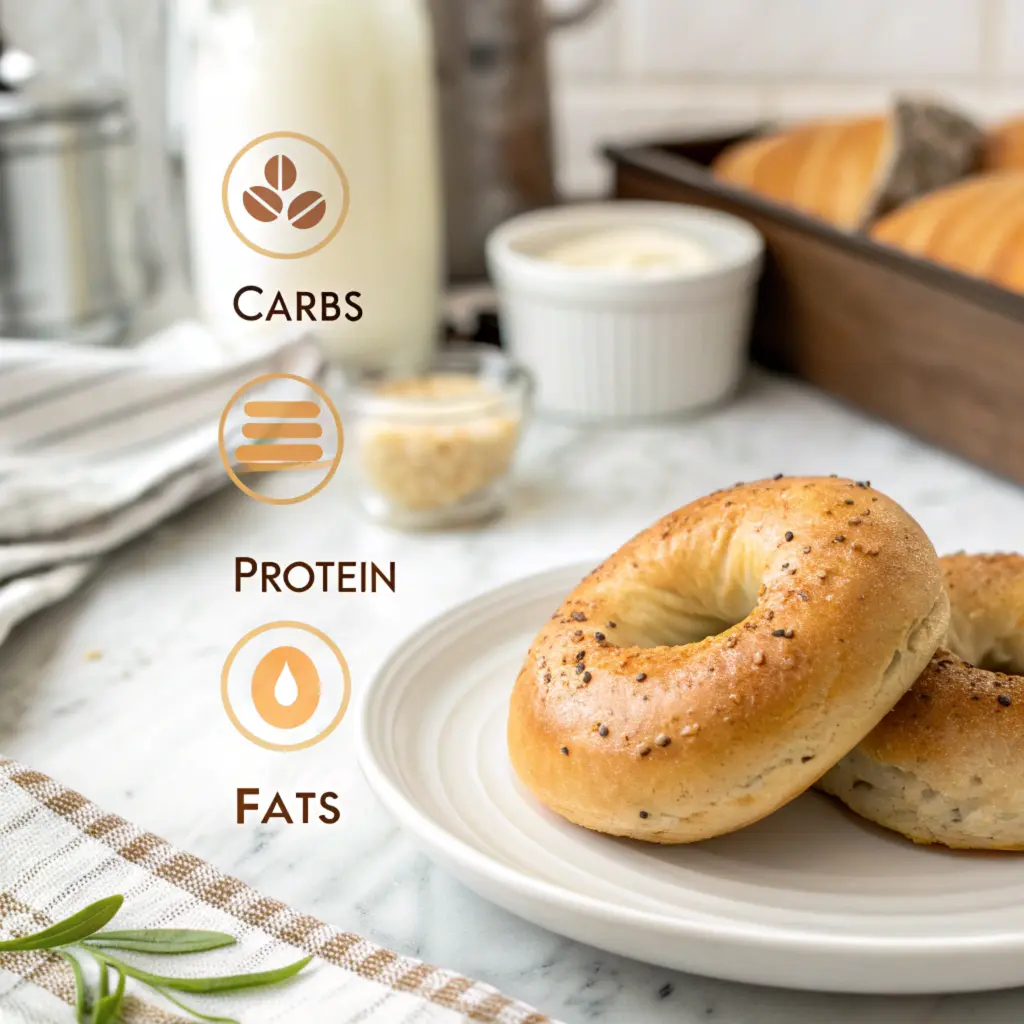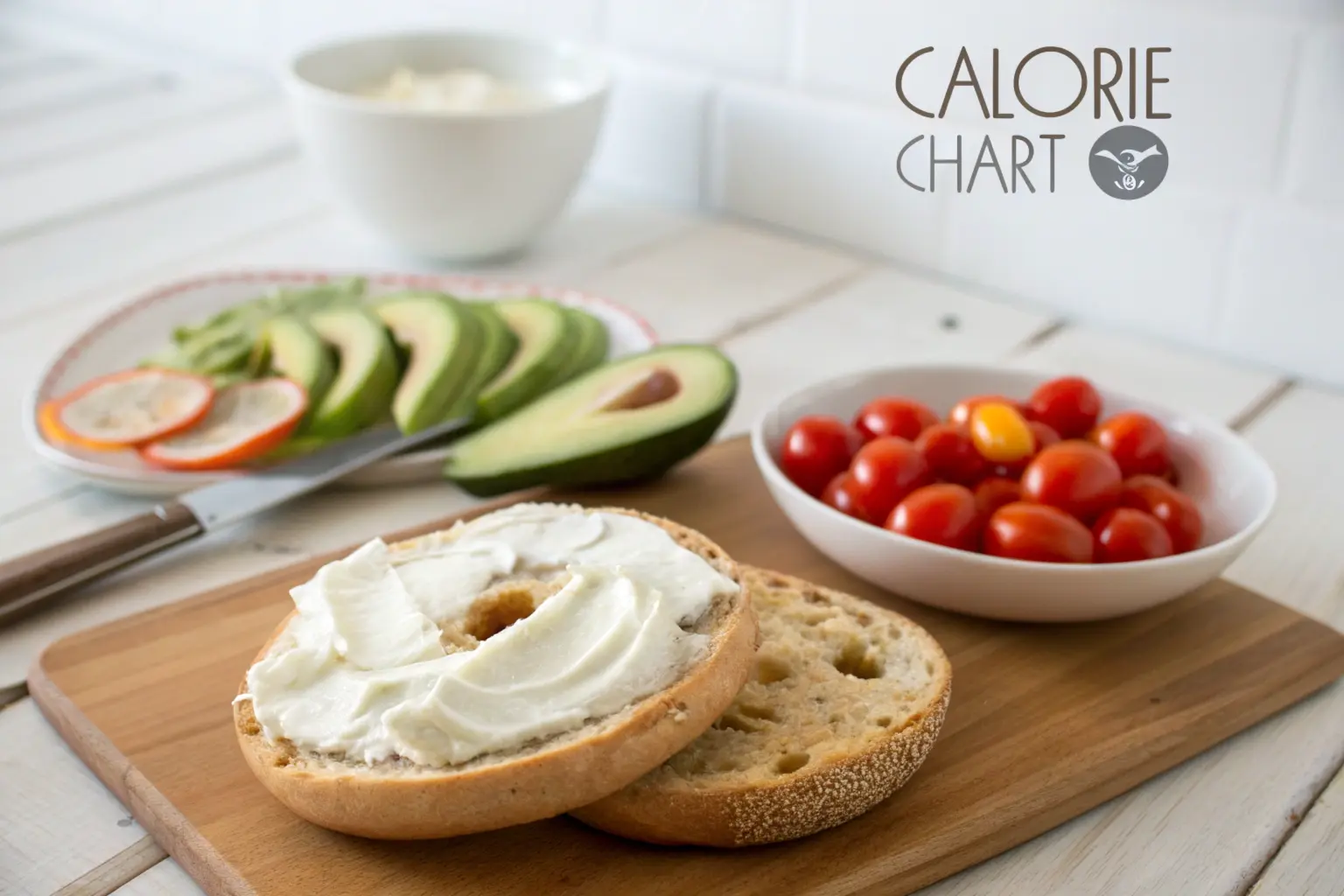Bagels and cream cheese are breakfast staples worldwide, but many people don’t realize how calorie-heavy they can be. While this classic combo satisfies cravings, understanding the caloric content helps you make smarter choices. This guide dives into how many calories you’ll find in a typical bagel with cream cheese, variations by size and type, and healthier alternatives for your diet. Let’s break it down part by part, starting with the basics.
Understanding the Caloric Content of a Bagel with Cream Cheese
Importance of Knowing Calorie Intake
Making informed choices about your diet starts with awareness. Bagels, while delicious and filling, often pack a calorie punch. For anyone tracking their intake, it’s helpful to know how many calories in a bagel and cream cheese you’re consuming in just one meal. Whether you’re maintaining a healthy weight, managing medical conditions, or simply curious, the numbers matter.
Overview of Bagels and Cream Cheese as a Popular Breakfast Choice
Bagels are beloved for their chewy texture and versatility, while cream cheese adds a creamy richness. Yet, this pairing often hides unexpected calories. A plain bagel with regular cream cheese might seem innocent, but when you account for size, toppings, and extras, the calories can climb quickly. Did you know larger bagels often contain double the calories of smaller ones? Pair that with full-fat cream cheese, and you’ve got a meal that’s calorie-dense but not always nutrient-rich.
This duo remains a favorite breakfast because it’s quick, customizable, and satisfying. However, if you want to stick to health goals, understanding the caloric breakdown can help you enjoy this treat without guilt.
If you’re intrigued by garlic cream cheese, check out our ultimate recipe and guide for Garlic Cream Cheese Bagels.
Caloric Content of a Plain Bagel
Bagels, by themselves, can be a satisfying and versatile choice, but their calorie count might surprise you. A plain bagel—without any toppings—is typically made with white flour, water, yeast, sugar, and salt. While the ingredients seem simple, their dense composition contributes significantly to their calorie content.
Variations by Bagel Size and Type
The calorie count in bagels varies widely depending on size and type. A standard-sized plain bagel (around 3-4 inches in diameter) contains about 250-300 calories. However, larger bagels, often found in cafes or grocery stores, can pack as much as 400-500 calories.
Beyond size, the type of bagel plays a key role in calorie variation. For instance:
- Whole Wheat Bagels: Slightly higher in fiber but with a similar calorie count to plain bagels.
- Everything Bagels: Add minimal extra calories due to seeds and seasonings, contributing 10-20 calories more.
- Gluten-Free Bagels: Often made with starch-heavy alternatives, sometimes resulting in slightly higher calorie counts.
- Multigrain Bagels: These contain more fiber and nutrients but are calorically comparable to plain bagels.

It’s worth noting that choosing smaller bagels or those made with nutrient-dense ingredients can make a noticeable difference in your calorie intake.
Caloric Content of Cream Cheese
Cream cheese adds the creamy, tangy element that transforms a simple bagel into a decadent breakfast treat. However, this indulgence is also where a significant chunk of the calories comes from.
A standard 1-ounce serving (about 2 tablespoons) of regular cream cheese contains roughly 100 calories, with most of these coming from fat. If you’re spreading generously, the calorie count can quickly double.
Differences Between Regular, Low-Fat, and Flavored Cream Cheeses

Not all cream cheeses are created equal, and their calorie content can vary depending on the type:
- Regular Cream Cheese: Contains around 100 calories per ounce, with about 9 grams of fat. This is the richest and most calorie-dense option.
- Low-Fat Cream Cheese: Offers a lighter alternative with about 70 calories per ounce and significantly less fat (around 4-5 grams).
- Flavored Cream Cheese: Varieties like strawberry, scallion, or honey walnut can add an extra 10-20 calories per ounce due to added sugars or flavorings.
Choosing low-fat or whipped cream cheese can help cut down calories while still delivering flavor.
Total Caloric Value of a Bagel with Cream Cheese
Now that we’ve broken down the individual components, let’s calculate the total caloric value of a bagel with cream cheese. Combining a standard plain bagel (300 calories) with a typical 1-ounce serving of cream cheese (100 calories) brings the total to about 400 calories. However, this number can increase depending on your portion sizes and choices.
Examples of Common Combinations
Here are a few popular bagel and cream cheese combinations, along with their approximate calorie counts:
- Plain Bagel + Regular Cream Cheese: 400 calories
- Everything Bagel + Low-Fat Cream Cheese: 370 calories
- Whole Wheat Bagel + Whipped Cream Cheese: 320 calories
- Cinnamon Raisin Bagel + Flavored Cream Cheese (e.g., Honey Walnut): 450 calories
Your choice of bagel and spread can significantly impact the calorie count, so customizing your selection is key to balancing indulgence with health.
Macronutrient Breakdown
Understanding the macronutrient composition of a bagel with cream cheese helps paint a clearer picture of its role in your diet. The primary macronutrients—carbohydrates, proteins, and fats—play a critical part in determining the meal’s energy value and overall nutritional impact.
Carbohydrates, Proteins, and Fats in Bagels and Cream Cheese
- Carbohydrates:
Bagels are a carb-heavy food, with a standard plain bagel containing approximately 50-60 grams of carbohydrates. These provide a quick energy source, but the type of flour used matters. Whole grain bagels, for instance, offer more complex carbs that release energy gradually, compared to refined white flour bagels that may cause blood sugar spikes. - Proteins:
Bagels alone are low in protein, with about 9-11 grams per serving. However, adding cream cheese introduces a small protein boost. Regular cream cheese contributes about 2 grams of protein per ounce, bringing the total to around 11-13 grams for the pairing. - Fats:
Fats come primarily from the cream cheese, which is why the type of spread you choose is significant. Regular cream cheese contains about 9 grams of fat per ounce, mostly from saturated fats. Low-fat or whipped versions reduce this amount considerably, offering about 4-5 grams of fat per serving.
Balancing the macronutrients by pairing your bagel with protein-rich toppings like smoked salmon or nut butter can help make this meal more satisfying and nutritious.
Vitamins and Minerals Present
While bagels and cream cheese may not be the most nutrient-dense breakfast option, they still contain essential vitamins and minerals that contribute to your diet.
Contributions to Daily Nutritional Requirements
- Iron:
Bagels made with enriched flour often contain iron, which is essential for oxygen transport in the blood. A plain bagel provides about 10-15% of your daily iron needs. - Calcium:
Cream cheese is a source of calcium, delivering around 2-3% of the recommended daily intake per ounce. This supports bone health and muscle function. - B Vitamins:
Bagels, particularly those made with whole grains, are a good source of B vitamins like thiamine, riboflavin, and niacin. These vitamins are crucial for energy production and maintaining a healthy metabolism. - Magnesium and Zinc:
Whole grain bagels also contribute small amounts of magnesium and zinc, which are vital for muscle health and immune support.
Whole grain bagels typically contain more dietary fiber, helping to keep you full longer and reduce hunger cravings. For more information about the benefits of whole grains, check out this guide from Harvard’s Nutrition Source.
While these nutrients are beneficial, they might not outweigh the high calorie count for some individuals. Adding nutrient-rich toppings such as fresh veggies or seeds can help turn this meal into a more balanced and healthful option.
Impact of How Many Calories in a Bagel and Cream Cheese on Weight Management
Bagels with cream cheese are a delightful breakfast staple, but their calorie density makes portion control essential, especially for those mindful of their weight. Understanding how many calories in a bagel and cream cheese can help you incorporate this treat into your diet without tipping the scale. While undeniably satisfying, this meal’s caloric contribution to your daily intake needs thoughtful management.
Role of Portion Control for Reducing How Many Calories in a Bagel and Cream Cheese
Portion control is a straightforward way to manage calorie intake while still enjoying a bagel and cream cheese. Opting for smaller sizes or eating just half of a bagel can significantly reduce calorie consumption. For instance:
Role of Portion Control for Reducing How Many Calories in a Bagel and Cream Cheese
Portion control is a straightforward way to manage calorie intake while still enjoying a bagel and cream cheese. Opting for smaller sizes or eating just half of a bagel can significantly reduce calorie consumption. For instance:
| Bagel Size/Type | Cream Cheese Type | Calories (Approx.) |
|---|---|---|
| Regular Plain Bagel (Whole) | Regular Cream Cheese | 400 calories |
| Regular Plain Bagel (Whole) | Low-Fat Cream Cheese | 370 calories |
| Half Plain Bagel | Regular Cream Cheese | 200 calories |
| Half Plain Bagel | Low-Fat Cream Cheese | 185 calories |
| Mini Bagel | Regular Cream Cheese | 150 calories |
| Mini Bagel | Low-Fat Cream Cheese | 130 calories |
Pairing a smaller portion with low-fat cream cheese or nutrient-rich toppings like eggs, smoked salmon, or avocado not only makes the meal more satisfying but also helps balance the calorie count.
Mini bagels, which typically contain 70-100 calories each, are another smart choice for portion control. By keeping portions in check, you can enjoy this breakfast without exceeding your calorie goals. Additionally, balancing this meal with lighter options throughout the day ensures that your total caloric intake stays on track.
How Many Calories in a Bagel and Cream Cheese Impact Blood Sugar Levels
Bagels are high in refined carbohydrates, which means they can significantly affect blood sugar levels. When eaten alone or paired with regular cream cheese, this combination can lead to a quick glucose spike, followed by a rapid drop. This can leave you feeling tired, sluggish, or even hungrier soon after eating.
How Diabetics Can Manage Bagels with Cream Cheese
For individuals with diabetes or those monitoring blood sugar, bagels with cream cheese require mindful preparation:
- Choose Whole-Grain Bagels: Whole-grain bagels, with their higher fiber content, digest more slowly and help stabilize blood sugar levels.
- Reduce Portion Sizes: A smaller serving reduces the glycemic load, making it easier to manage blood sugar.
- Pair with Protein-Rich Foods: Toppings like peanut butter, avocado, or lean proteins add nutritional value and slow carbohydrate absorption.
Switching to low-fat cream cheese or alternatives such as Greek yogurt spreads can further lower the fat and sugar content, making the meal a better option for those with blood sugar concerns. By practicing balance and moderation, anyone can enjoy bagels and cream cheese while managing their health effectively.
Selecting Whole Grain or Multigrain Bagels
Choosing whole grain or multigrain bagels is a smart step toward a healthier breakfast. Unlike their refined white flour counterparts, these bagels are made with whole grains, which retain the bran and germ, offering more nutrients and fiber.
Whole grain bagels provide complex carbohydrates, which digest more slowly, helping you stay fuller for longer and avoiding sudden blood sugar spikes. On average, a whole-grain bagel contains the same calories as a plain bagel (~250-300 calories), but it delivers additional benefits like:
- Increased Fiber: Promotes digestion and helps manage cholesterol levels.
- Enhanced Satiety: Makes you feel full faster, reducing the temptation to overeat.
Multigrain bagels, on the other hand, combine several grains such as oats, flax, or quinoa. These grains not only add texture and flavor but also provide essential nutrients like magnesium, zinc, and B vitamins. If you’re aiming to make your bagel healthier without sacrificing taste, swapping white bagels for whole grain or multigrain options is a great move.
Opting for Low-Fat or Alternative Spreads
Cream cheese might be the go-to bagel topping, but low-fat or alternative spreads can slash the calorie count without compromising on taste. For example:
- Low-Fat Cream Cheese: Reduces calories by nearly 30% compared to the regular version.
- Whipped Cream Cheese: Thanks to its airy texture, it’s lower in calories per tablespoon.
- Greek Yogurt Spreads: These are high in protein and lower in fat, offering a creamy and tangy alternative.
- Nut Butters: Almond or peanut butter provides healthy fats, proteins, and an energy boost.
If you’re feeling adventurous, spreads like hummus or avocado mash are flavorful, nutrient-packed options that add fiber, vitamins, and healthy fats to your meal. Not only are these alternatives lower in saturated fat, but they’re also a fantastic way to make your bagel a well-rounded choice.
Adding Nutrient-Dense Toppings
To elevate your bagel from a simple breakfast to a nutrient-dense meal, adding toppings rich in vitamins, minerals, and fiber is key. Start by choosing ingredients that complement your health goals and add variety.
Incorporating Fruits and Vegetables
Fruits and vegetables not only enhance flavor but also pack your bagel with antioxidants, fiber, and essential nutrients. Popular combinations include:
- Avocado Slices with Tomato: A classic pairing that provides healthy fats, vitamin C, and lycopene.
- Sliced Bananas with Honey: A naturally sweet topping that adds potassium and energy.
- Cucumber and Sprouts: Perfect for a refreshing, low-calorie option full of fiber and water content.
- Roasted Vegetables: Bell peppers, zucchini, and eggplant lend a savory twist with a nutrient boost.
Adding these toppings helps balance the calorie load of your bagel while ensuring that it delivers essential nutrients. It’s an easy way to turn your favorite breakfast into a more satisfying and wholesome meal.

FAQs About Bagels and Cream Cheese
Is a bagel and cream cheese healthy?
A bagel with cream cheese can be part of a healthy diet if consumed in moderation. However, it is calorie-dense and often low in essential nutrients. Choosing whole-grain bagels, low-fat cream cheese, and adding nutrient-rich toppings like vegetables can make it a more balanced option.
For more insights into whether bagels and cream cheese can fit into a healthy lifestyle, check out our article on Is Bagel and Cream Cheese Healthy?.
Can diabetics eat bagels and cream cheese?
Yes, but with caution. Diabetics should opt for whole-grain bagels, which have a lower glycemic index, and limit portion sizes to reduce blood sugar spikes. Pairing the meal with protein-rich or fiber-rich toppings can also help stabilize blood sugar levels.
For a more detailed guide, check out our article on Can Diabetics Eat Bagels and Cream Cheese?.
What is good on a bagel with cream cheese?
Toppings like smoked salmon, sliced avocado, cucumber, tomatoes, or sprouts pair wonderfully with cream cheese. Sweet options like fresh fruits or a drizzle of honey can also complement the creamy texture.
For even more ideas and inspiration, visit our detailed guide on What Is Good on a Bagel with Cream Cheese.
How can I reduce the calorie content of my bagel with cream cheese?
Choose smaller bagels or eat half a bagel to cut calories. Swap regular cream cheese for low-fat or whipped versions, or try alternative spreads like Greek yogurt or avocado. Adding nutrient-dense toppings like fresh vegetables can increase satiety without significantly increasing calories.
Can I include bagels with cream cheese in a weight loss diet?
Yes, bagels with cream cheese can fit into a weight loss plan if portion sizes are controlled. Opt for whole-grain bagels and low-fat spreads, and consider adding high-protein or fiber-rich toppings to keep you full longer. Balancing this meal with lower-calorie foods throughout the day is also important.

